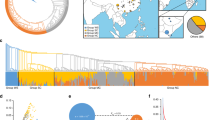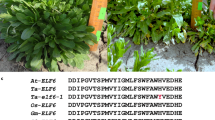Abstract
A key event in the domestication and breeding of the oil palm Elaeis guineensis was loss of the thick coconut-like shell surrounding the kernel. Modern E. guineensis has three fruit forms, dura (thick-shelled), pisifera (shell-less) and tenera (thin-shelled), a hybrid between dura and pisifera1,2,3,4. The pisifera palm is usually female-sterile. The tenera palm yields far more oil than dura, and is the basis for commercial palm oil production in all of southeast Asia5. Here we describe the mapping and identification of the SHELL gene responsible for the different fruit forms. Using homozygosity mapping by sequencing, we found two independent mutations in the DNA-binding domain of a homologue of the MADS-box gene SEEDSTICK (STK, also known as AGAMOUS-LIKE 11), which controls ovule identity and seed development in Arabidopsis. The SHELL gene is responsible for the tenera phenotype in both cultivated and wild palms from sub-Saharan Africa, and our findings provide a genetic explanation for the single gene hybrid vigour (or heterosis) attributed to SHELL, via heterodimerization. This gene mutation explains the single most important economic trait in oil palm, and has implications for the competing interests of global edible oil production, biofuels and rainforest conservation6.
This is a preview of subscription content, access via your institution
Access options
Subscribe to this journal
Receive 51 print issues and online access
$199.00 per year
only $3.90 per issue
Buy this article
- Purchase on Springer Link
- Instant access to full article PDF
Prices may be subject to local taxes which are calculated during checkout




Similar content being viewed by others

Accession codes
Primary accessions
GenBank/EMBL/DDBJ
Data deposits
E. guineensis and E. oleifera genome sequences have been deposited at DDBJ/EMBL/GenBank under the accessions ASJS00000000 and ASIR00000000, respectively. Gene sets are available at http://genomsawit.mpob.gov.my.
References
Janssens, P. Le palmier à huile au Congo Portugais et dans l’enclave de Cabinda. Descriptions de principales Variétés de Palmier (Elaeis guineensis). Bull. Agric. Congo Belge. 18, 29–92 (1927)
Devuyst, A. Selection of the oil palm (Elaeis guineensis) in Africa. Nature 172, 685–686 (1953)
Hartley, C. The Oil Palm 47–94 (Longman, 1988)
Rajanaidu, N. et al. in Advances in Oil Palm Research (eds Basiron, Y., Jalani, B. S. & Chan, K. W. ) 171–237 (Malaysian Palm Oil Board, 2000)
Corley, R. H. V. & Tinker, P. B. The Oil Palm 4th edn, 1–26 (Blackwell Science, 2003)
Danielsen, F. et al. Biofuel plantations on forested lands: double jeopardy for biodiversity and climate. Conserv. Biol. 23, 348–358 (2009)
Beirnaert, A. & Vanderweyen, R. Contribution à l’étude génétique et biométrique des variétiés d’Elaeis guineensis Jacq. Publ. Inst. Nat. Etude Agron. Congo Belge. Ser. Sci. 27, 1–101 (1941)
Godding, R. Observation de la production de palmiers selectionnes a Mongana (Equateur). Bull. Agric. Congo Belge. 21, 1263 (1930)
Billotte, N. et al. Microsatellite-based high density linkage map in oil palm (Elaeis guineensis Jacq.). Theor. Appl. Genet. 110, 754–765 (2005)
Mayes, S., Jack, P. L., Corley, R. H. & Marshall, D. F. Construction of a RFLP genetic linkage map for oil palm (Elaeis guineensis Jacq.). Genome 40, 116–122 (1997)
Moretzsohn, M. C., Nunes, C. D. M., Ferreira, M. E. & Grattapaglia, D. RAPD linkage mapping of the shell thickness locus in oil palm (Elaeis guineensis Jacq.). Theor. Appl. Genet. 100, 63–70 (2000)
Singh, R. et al. Oil palm genome sequence reveals divergence of interfertile species in Old and New Worlds. Nature http://dx.doi.org/10.1038/nature12309 (this issue)
Rajanaidu, N., Rao, V., Abdul Halim, H. & Ong, A. S. H. Genetic resources. New developments in oil palm breeding. Elaeis 1, 1–10 (1989)
Gschwend, M. et al. A locus for Fanconi anemia on 16q determined by homozygosity mapping. Am. J. Hum. Genet. 59, 377–384 (1996)
Lander, E. S. & Botstein, D. Homozygosity mapping: a way to map human recessive traits with the DNA of inbred children. Science 236, 1567–1570 (1987)
Favaro, R. et al. MADS-box protein complexes control carpel and ovule development in Arabidopsis. Plant Cell 15, 2603–2611 (2003)
Pinyopich, A. et al. Assessing the redundancy of MADS-box genes during carpel and ovule development. Nature 424, 85–88 (2003)
Huang, H. et al. DNA binding properties of two Arabidopsis MADS domain proteins: binding consensus and dimer formation. Plant Cell 8, 81–94 (1996)
Immink, R. G., Kaufmann, K. & Angenent, G. C. The ‘ABC’ of MADS domain protein behaviour and interactions. Semin. Cell Dev. Biol. 21, 87–93 (2010)
Bhasker, S. & Mohankumar, C. Association of lignifying enzymes in shell synthesis of oil palm fruit (Elaeis guineensis–dura variety). Indian J. Exp. Biol. 39, 160–164 (2001)
Dinneny, J. R. & Yanofsky, M. F. Drawing lines and borders: how the dehiscent fruit of Arabidopsis is patterned. Bioessays 27, 42–49 (2005)
Vrebalov, J. et al. Fleshy fruit expansion and ripening are regulated by the Tomato SHATTERPROOF gene TAGL1. Plant Cell 21, 3041–3062 (2009)
Tani, E., Polidoros, A. N. & Tsaftaris, A. S. Characterization and expression analysis of FRUITFULL- and SHATTERPROOF-like genes from peach (Prunus persica) and their role in split-pit formation. Tree Physiol. 27, 649–659 (2007)
Tani, E. et al. Characterization and expression analysis of AGAMOUS-like, SEEDSTICK-like, and SEPALLATA-like MADS-box genes in peach (Prunus persica) fruit. Plant Physiol. Biochem. 47, 690–700 (2009)
Kramer, E. M., Jaramillo, M. A. & Di Stilio, V. S. Patterns of gene duplication and functional evolution during the diversification of the AGAMOUS subfamily of MADS box genes in angiosperms. Genetics 166, 1011–1023 (2004)
Zahn, L. M. et al. Conservation and divergence in the AGAMOUS subfamily of MADS-box genes: evidence of independent sub- and neofunctionalization events. Evol. Dev. 8, 30–45 (2006)
Dreni, L. et al. The D-lineage MADS-box gene OsMADS13 controls ovule identity in rice. Plant J. 52, 690–699 (2007)
Cui, R. et al. Functional conservation and diversification of class E floral homeotic genes in rice (Oryza sativa). Plant J. 61, 767–781 (2010)
Veitia, R. A. & Vaiman, D. Exploring the mechanistic bases of heterosis from the perspective of macromolecular complexes. FASEB J. 25, 476–482 (2011)
Krieger, U., Lippman, Z. B. & Zamir, D. The flowering gene SINGLE FLOWER TRUSS drives heterosis for yield in tomato. Nature Genet. 42, 459–463 (2010)
Singh, R. et al. Mapping quantitative trait loci (QTLs) for fatty acid composition in an interspecific cross of oil palm. BMC Plant Biol. 9, 114 (2009)
Acknowledgements
We thank J. Jansen for assistance with JoinMap, and Beijing Genome Institute, The Genome Institute at Washington University, Tufts University Core Facility and the Arizona Genome Institute for mapping and genome sequencing. We thank Kulim, Sime Darby, FELDA Agricultural Services, United Plantations and Applied Agricultural Resources for providing materials and phenotype information of individual palms. Phylogeny, Inc. performed in situ hybridization services. Creative Biolabs performed yeast two-hybrid co-transformations and interaction assays. We thank J. Birchler and Z. Lippman for discussions on hybrid vigour. We appreciate the constant support of Y. M. Choo, and the Ministry of Plantation Industries and Commodities, Malaysia. The project was endorsed by the Cabinet Committee on the Competitiveness of the Palm Oil Industry (CCPO) and funded by the Malaysian Palm Oil Board. R.A.M. is supported by a grant from National Science Foundation 0421604 ‘Genomics of Comparative Seed Plant Evolution’.
Author information
Authors and Affiliations
Contributions
R.S. initiated work on the SHELL marker/gene. R.S., E.-T.L.L., M.O.-A. and R.S. conceptualized the research programme. R.S., E.-T.L.L., M.O.-A., R.N., M.A.A.M., N.L., S.W.S., J.M.O., R.S. and R.A.M. developed the overall strategy, designed experiments and coordinated the project. R.A.M. conceptualized the homozygosity mapping strategy. R.S., R.N. and R.A.M identified samples for homozygosity mapping. R.N. and M.D.A. developed and maintained the mapping population and assisted in phenotyping. R.S., M.O.-A., L.C.-L.O., N.-C.T., J.N., N.L., M.A.B., B.B., A.V.B., C.W., J.M.O. and R.S. conducted laboratory experiments and data analyses. R.S. and L.C.-L.O. constructed the genetic map. E.-T.L.L., R.R., K.-L.C., M.A.H., N.A., S.W.S., M.H., A.V.B. and C.W. performed bioinformatics analyses. N.L., A.V.B., C.W., J.M.O., R.S. and R.A.M. resequenced the candidate gene and characterized the mutations. R.S., E.-T.L.L., M.O.-A., R.N., N.L., S.W.S., J.M.O., R.S. and R.A.M. prepared and revised the manuscript.
Corresponding authors
Ethics declarations
Competing interests
R.A.M. is a consultant for Orion Genomics, LLC.
Supplementary information
Supplementary Information
This file contains Supplementary Figures 1-5, Supplementary Table 1 and a Supplementary reference. (PDF 704 kb)
Rights and permissions
About this article
Cite this article
Singh, R., Low, ET., Ooi, LL. et al. The oil palm SHELL gene controls oil yield and encodes a homologue of SEEDSTICK. Nature 500, 340–344 (2013). https://doi.org/10.1038/nature12356
Received:
Accepted:
Published:
Issue Date:
DOI: https://doi.org/10.1038/nature12356
This article is cited by
-
Identification of two major QTLs for pod shell thickness in peanut (Arachis hypogaea L.) using BSA-seq analysis
BMC Genomics (2024)
-
Association mapping of selected oil palm germplasm reveals novel and known genomic regions influencing vegetative and bunch component traits
Genetic Resources and Crop Evolution (2023)
-
Genetic gains for obtaining improved progenies of oil palm in Colombia
Euphytica (2023)
-
High-resolution genetic linkage map and height-related QTLs in an oil palm (Elaeis guineensis) family planted across multiple sites
Physiology and Molecular Biology of Plants (2023)
-
Large-scale genomic and transcriptomic profiles of rice hybrids reveal a core mechanism underlying heterosis
Genome Biology (2022)
Comments
By submitting a comment you agree to abide by our Terms and Community Guidelines. If you find something abusive or that does not comply with our terms or guidelines please flag it as inappropriate.


